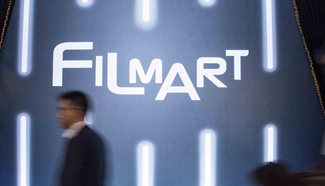SAN FRANCISCO, March 13 (Xinhua) -- Kwabena Boahen, a professor of bioengineering and of electrical engineering at Stanford University, has envisioned a new generation of computers to be brain-like, or neuromorphic, machines that are vastly more efficient than the conventional digital computers.
As conventional computer chips aren't up to the challenges posed by next-generation autonomous drones and medical implants, "we've gotten to the point where we need to do something different," said Boahen, also a member of Stanford Bio-X and the Stanford Neurosciences Institute. "Our lab's three decades of experience has put us in a position where we can do something different, something competitive."
The Moore's law, an observation made by Intel Corp. co-founder Gordon Moore in 1965, has held up pretty well for five decades: roughly every two years, the number of transistors one could fit on a chip doubled, all while costs steadily declined. However, transistors and other electronic components are so small they're beginning to bump up against fundamental physical limits on their size. And there are needs for computing to be ever faster, cheaper and more efficient.
In laying out in the latest issue of Computing in Science and Engineering, Boahen believes that the future is now.
While others have built brain-inspired computers, Boahen was quoted as saying in a news release, he and his collaborators have developed a five-point prospectus for how to build neuromorphic computers that directly mimic in silicon what the brain does in flesh and blood.
The first two points of the prospectus concern neurons themselves, which unlike computers operate in a mix of digital and analog mode. In their digital mode, neurons send discrete, all-or-nothing signals in the form of electrical spikes, akin to the ones and zeros of digital computers. But they process incoming signals by adding them all up and firing only once a threshold is reached - more akin to a dial than a switch.
That observation led Boahen to try using transistors in a mixed digital-analog mode. Doing so, it turns out, makes chips both more energy efficient and more robust when the components do fail, as about 4 percent of the smallest transistors are expected to do. From there, Boahen builds on neurons' hierarchical organization, distributed computation and feedback loops to create a vision of an even more energy efficient, powerful and robust neuromorphic computer.
Over the last 30 years, Boahen's lab has implemented most of their ideas in physical devices, including Neurogrid, one of the first truly neuromorphic computers. In another two or three years, Boahen said, he expects they will have designed and built computers implementing all of the prospectus's five points.
"It's complementary," Boahen said, adding that "it's not going to replace current computers." As most personal computers operate nowhere near the limits on conventional chips, neuromorphic computers would be most useful in embedded systems that have extremely tight energy requirements, such as very low-power neural implants or on-board computers in autonomous drones.












